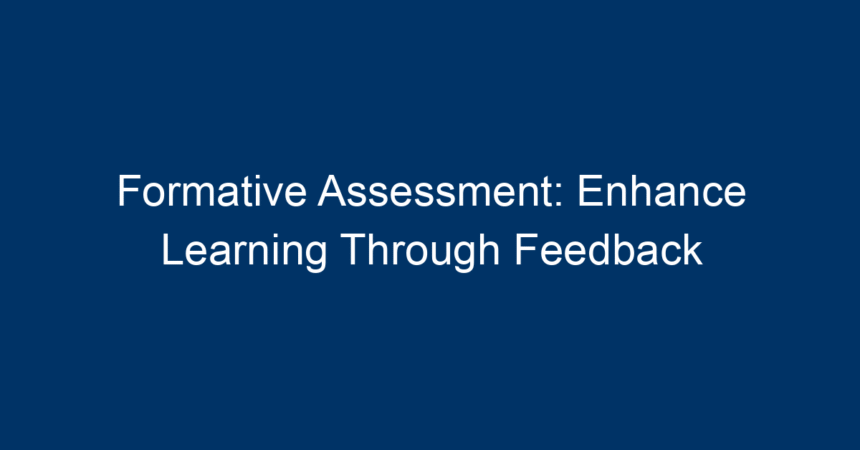In the bustling world of education, the pursuit of effective teaching methods is ever-present. One noteworthy strategy is formative assessment — a powerful tool that fosters student learning and promotes academic growth. Unlike traditional assessments that merely gauge final performance, formative assessments focus on learning progress, providing timely feedback that champions improvement. This article explores the profound impact of formative assessments on education, revealing how they can enhance learning through actionable feedback.
Understanding Formative Assessment
Definition and Purpose
Formative assessment refers to a range of evaluation methods used during the learning process. The primary purpose is to showcase student understanding, skill acquisition, and progression toward learning objectives. This cyclical practice not only identifies learning gaps but also enables educators to tailor their instruction, thereby enhancing the overall educational experience.
The Difference Between Formative and Summative Assessment
It’s essential to distinguish between formative and summative assessments:
-
Formative Assessment: Ongoing, interactive, and focused on the learning process. Examples include quizzes, discussions, and classroom observations.
- Summative Assessment: Culminative, occurring at the end of an instructional period. This includes final exams and standardized tests.
While both assessments serve crucial roles in education, formative assessments are particularly effective in creating a continued dialogue about learning, allowing students and teachers to adjust their approaches dynamically.
The Importance of Feedback in Formative Assessment
Real-Time Insights
Feedback is the bedrock of effective formative assessment. Timely, specific feedback helps students understand their strengths and areas needing improvement. This immediate response fosters a growth mindset, encouraging learners to view challenges as opportunities rather than obstacles.
Building Student Confidence
Constructive feedback can significantly boost student confidence. When learners receive positive reinforcement, they are more likely to engage with the material and take risks in their learning. For instance, instead of receiving a grade alone, a student may receive insights on how to enhance their project, instilling a sense of achievement and ownership over their work.
Techniques for Implementing Formative Assessment
1. Think-Pair-Share
This collaborative strategy encourages students to think about a question individually, discuss their thoughts with a partner, and then share with the larger group. This approach not only provides instant feedback for both students and teachers but also fosters peer-to-peer learning.
2. Exit Tickets
At the end of a lesson, students submit a brief response to a prompt, such as summarizing what they learned or posing questions they still have. Exit tickets allow teachers to gauge understanding quickly and adapt future lessons accordingly.
3. Digital Tools
In the age of technology, various online platforms facilitate formative assessment. Tools like Kahoot!, Google Forms, and Socrative enable teachers to create quick quizzes and polls that provide instant feedback on student comprehension. These digital assessments can engage students and make assessment low-stakes while still informative.
4. Peer Assessment
Encouraging students to review each other’s work fosters analytical skills and collaborative learning. Peer assessment not only provides diverse feedback but also cultivates a community of learners invested in each other’s success.
5. Self-Assessment
Teaching students to evaluate their work through rubrics or reflective journaling empowers them to take ownership of their learning journey. Self-assessment promotes metacognition, allowing students to recognize their learning strategies and refine them for future tasks.
Challenges of Formative Assessment
While formative assessment holds immense potential, it is not without challenges. Educators may feel overwhelmed by the need to provide timely and effective feedback, especially in larger classrooms. Additionally, some students might struggle with accepting feedback, fearing judgment rather than using it as a learning tool.
Overcoming Challenges
-
Professional Development: Educators can benefit from training that enhances their skills in formative assessment techniques. Workshops and resources can provide valuable insights into effective feedback methods.
-
Creating a Safe Environment: Cultivating a classroom atmosphere where mistakes are viewed as opportunities for growth can help students embrace feedback. Clear communication about the purposes of formative assessment is key.
- Utilizing Technology: Leveraging educational technology can streamline the feedback process, allowing teachers to efficiently collect and analyze student data.
The Impact of Formative Assessment on Student Learning
Increased Engagement
When students understand that their performance is an ongoing journey rather than a final destination, they become more engaged in the learning process. Formative assessments encourage active participation, prompting students to take initiative in their improvement.
Higher Achievement
By identifying misconceptions early, formative assessment facilitates targeted interventions. Research indicates that students who receive regular, constructive feedback tend to achieve higher levels of understanding and academic performance. The continuous nature of feedback helps students connect concepts, leading to deeper learning.
Enhanced Motivation
The cycle of feedback and revision nurtures intrinsic motivation. When students see their progress highlighted through formative assessments, they develop a desire to improve further, fostering a continuous learning habit.
Conclusion: Actionable Insights for Educators
Formative assessment, particularly when harnessed effectively, can revolutionize the educational experience. By prioritizing ongoing feedback and creating an environment where learning is celebrated, educators can truly enhance student learning.
Takeaways for Implementing Formative Assessment
-
Integrate Regular Feedback: Use various formative assessment techniques throughout your curriculum to ensure that feedback is constant and constructive.
-
Empower Students: Encourage self-assessment and peer feedback to create a collaborative classroom culture.
-
Use Technology: Leverage digital tools to enhance the efficiency and engagement of formative assessments.
- Create a Growth Mindset: Foster an environment where mistakes are part of the learning process, and encourage students to view feedback as a pathway to improvement.
In embracing these strategies, educators can maximize the potential of formative assessment, elevating the learning experience and paving the way for student success. Remember, the goal is not just to evaluate, but to uplift, guide, and inspire lifelong learners.




